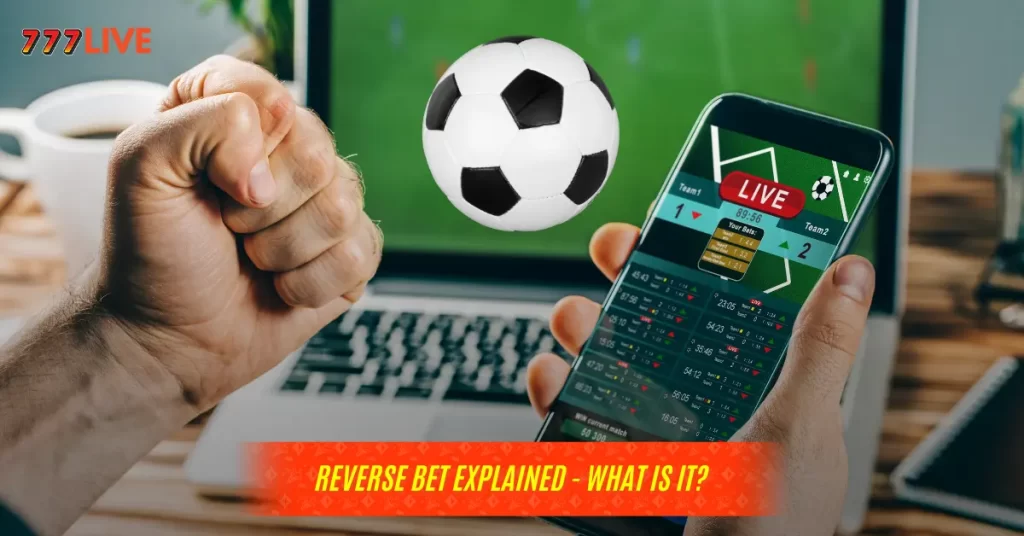A Reverse Bet is a popular betting structure in sports wagering that provides a unique way to maximize potential winnings while managing risks. Unlike standard straight bets or parlays bet, a Reverse Bet intricately combines multiple bets, allowing bettors to profit from different combinations of outcomes in a more strategic format.
In this article, 777Live will break down what Reverse Bet, what it works, and the reasons why it might be a valuable tool for experienced bettors.
Reverse Bet – What Is It?
Action Reverse bets go hand in hand with ‘If Bets,’ a betting type that places a link between all your bets that are conditional on the one prior. Reverse bets allow you to make your if bet with reverse action, meaning you have two wagers placed both ways. If your first wager wins or pushes, then your second wager will be placed, or wager two wins set one.
An action reverse bet allows you to bet on two to eight games, similar to a parlay wager, but the wagers are placed conditionally on the one before. This means your first bet will need to win for your second bet to be placed, and then your second bet will need to win for your third to be placed, and so on. Then, with action reverse betting, you will have a secondary wager that goes in reverse.
So, your fourth bet will need to win before your third, your third bet will need to win before your second bet is placed, and the second will need to win before your first bet is placed.
Essentially, it’s a form of structured wagering that allows bettors to create a combination of multiple bets where each wager depends on the previous one. This betting way is particularly popular in sports betting and is designed to balance both potential profit and risk by providing returns from various winning outcomes, even if not all bets are successful.
It will be easier to understand an IF bet if you think of it as an ‘action in sequence‘ bet. If you place a three-match IF bet and the first match, Bet Type A, wins, then your bet on the second match, Bet Type B, still has action.
If your Bet Type A loses, your bets on Bet Type B and the third, Bet Type C, are canceled. Your bet on the Type C game is active on the winning of the Type B game. In case the bet on the Type C game is a loss, your bet is over but of course, you get to keep the winnings from the first bet.
Therefore, in an IF bet, the number of your picks up to six, depending on the bookbinder, will not be counted in case the first selected team fails to win.
Type of Reverse Bets
This type of betting is often broken down into two forms:
- Action Reverse Bet – In this format, every combination is activated regardless of whether the first leg of the bet wins or loses.
- Win Reverse Bet – Here, subsequent bets are only activated if the first leg is successful, which slightly reduces risk but also limits potential profit.
How Reverse Bet Works?

In this betting way, a bettor selects multiple games or events to include in the structure. Each one of those events will have an “if bet” component covering its outcome and combined with others in different ways. The most common Reverse Bets involve two or more events, with each potential outcome covered in separate “if” clauses.
Let’s deal with a betting concerning two events, Team A and Team B:
- If Team A wins, a bet is placed on Team B.
- Separately, if Team B wins, a bet is placed on Team A.
Here, this betting could have covered all the combinations because if either of the two teams won, then he would come out as a winner, and in case of a tie, the gain was a notch higher.
This structure offers, in essence, more chances to take a profit, while minimizing the possibility of losing all bets in case the result is not favorable.
Why choose a reverse bet?
The main reasons many knowledgeable gamblers like Reverse Bets involve the control and flexibility that a bettor gets. While most straight parlays are completely dependent on all selections resulting in wins to yield a payout, this added security and the possibility of winning on multiple outcomes make it a Reverse Bet.

The critical advantages of a Reverse Bet come in:
- Risk Management: In the case of a Reverse Bet, since all combinations are covered, one does not face complete loss in case one or more of the bets fail.
- Flexibility: Because of the openness of Reverse Bets, they can be tailored for most any given event, resulting in very versatile and adaptable bets with various betting strategies.
- Optimized Profit Potential: A well-structured Reverse Bet, though with varied profit, has the possibility of yielding multiple payouts, which significantly allows the potential return to be maximum with several winning outcomes.
The bottom line
While Reverse bets do have their advantages, they also have some downsides. Consider the pros and cons of using bets to help you decide if they’re right for you.


